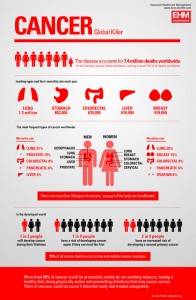The doctor says: “We offer two kinds of surgery for your cancer. Both procedures have 80 percent cure rates. After the first kind, 4 percent of patients have serious complications. In the second type, 20 percent simply die. No pressure to decide, but the sooner we start …”
Wishing you hadn’t slept through statistics class – trying to remember what went wrong with Uncle Joe’s surgery, and longing for the days when doctors knew best – you seek counsel in a decision-support tool, online or at the nearest cancer resource center.
“In fact, there are more than 40 tools to help people make informed decisions in cancer prevention, screening and treatment,” says Valerie F. Reyna, professor of human development in Cornell’s College of Human Ecology. “The more effective decision-support aids help with the numeracy problem – is a 10 percent chance riskier than one in a thousand? But not all tools help patients use their values, emotions and life experience to make decisions that affect their lives and their families’ future.”
Writing in the February-March 2015 special issue of American Psychologist, in an article titled “Decision Making and Cancer,” Reyna and her research colleagues want support tools to accommodate what they call “bottom-line gist options” that swirl though a patient’s mind – along with “verbatim” details about probable risk and whatever else the doctor said.
Gist is at the core of Fuzzy Trace Theory (which Reyna applied most recently to patients’ decisions to take antibiotics even though the misery is probably caused by viruses, not bacteria), and there’s nothing wrong with listening to one’s heart, Reyna says.
Reyna and her co-authors explain that “gist involves understanding meaning (insight in the gestalt sense) – integrating dimensions of information to distill its essence, not just processing fewer dimensions of information that are ‘good enough.’” Although people incorporate both verbatim details and gist in decision making, “they generally have a fuzzy processing (gist) preference” for information, the authors report.
The researchers offer this prescription for a Fuzzy Trace Theory-based cancer-decision tool: Ensure that patients understand the essential gist meaning of information; remind patients of an array of simple social and moral values that are important to them and that have relevance to the decision at hand; and assist patients in applying their values throughout the decision process.
“Every phase of the cancer continuum – from prevention, screening and diagnosis to treatment, survivorship and end of life – is fraught with challenges to our abilities to make informed decisions,” says Reyna. “People are not optimal decision makers. We struggle with complex information about benefits and risks, tradeoffs and uncertainties in cancer treatment.”
An impassionate computer could make optimal decisions on our behalf – disregarding the gist of what we think is best for us, Reyna adds. But the computer is too literal to make the best decisions for people, Reyna says: “Decision support should strive to capture the gist, the essential bottom line, of patients’ options.”
Reyna, director of the Human Neuroscience Institute in the College of Human Ecology, is the first author on the paper along with Wendy L. Nelson, National Cancer Institute; Paul K. Han, Maine Medical Center, Scarborough, Maine; and Michael P. Pignone, University of North Carolina at Chapel Hill.
Preparation of the American Psychologist report was supported, in part, by awards from the National Cancer Institute of the National Institutes of Health and the National Institute of Nursing Research.


